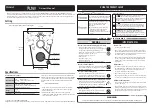
Note: A electronic volt meter (digital preferred) with a millivolt setting is needed to make bias
readings/adjustments. A digital multimeter can be found cheaply at any hardware store. Here's
the cheapest we've found on the web, which is totally sufficient for the job:
http://www.harborfreight.com/7-function-digital-multimeter-90899.html
With a speaker cabinet plugged in,turn on the amp, let it warm up for about 30 seconds, then
take off Standby into Play mode (The volume can be all the way down for the test). Let the
amp run for a minute or two.
Next, set the multimeter to DC millivolts (mV).
Insert the black test probe into the black jack on the rear panel, and the red probe into any of
the red jacks.
N
ote: The 4 output tubes work in pairs; the left bias control adjust the bias voltage for V1 and V2,
while the right control adjusts the bias voltage for V3 and V4. While the output tubes can only be
adjusted in pairs, a test jack is provided for each individual tube to provide more accurate bias
monitoring (e.g. trying to find a faulty tube).
For the correct bias range you should read between:
•
32mV to 39 mV per tube when using EL34s
•
39mV to 46mV per tube when using 6L6s
•
or 46mV to 53mV per tube when using KT88s
Anything lower settings will not harm the tubes, but anything higher than:
•
43mV and up per tube for EL34s
•
52mV and up for 6L6s
•
61mV and up for KT88s
will lead to shortened output tube life or imminent failure.
Remove the red probe, and insert it into the other jack to check the reading. Ideally it should
be the same as the first reading, but a couple millivolts difference is no big deal.
Here are some situations where you may need to check the bias:
•
The amp sounds thin, or abnormal in any way.
•
The amp is quieter than normal.
6






























